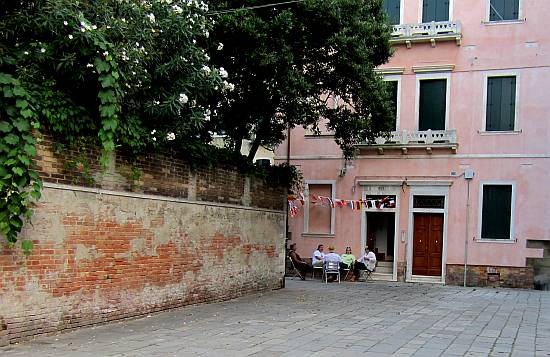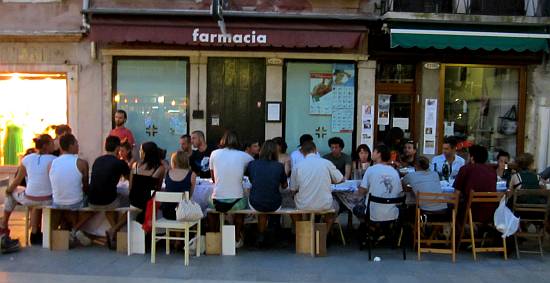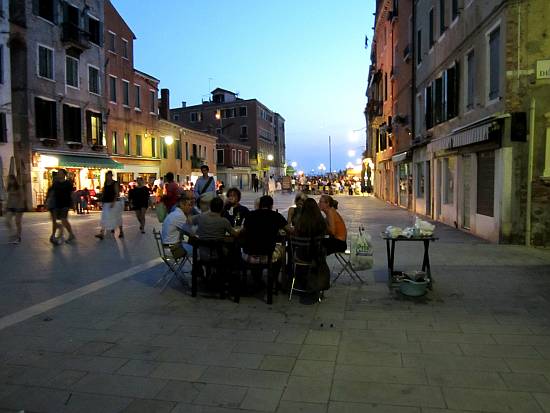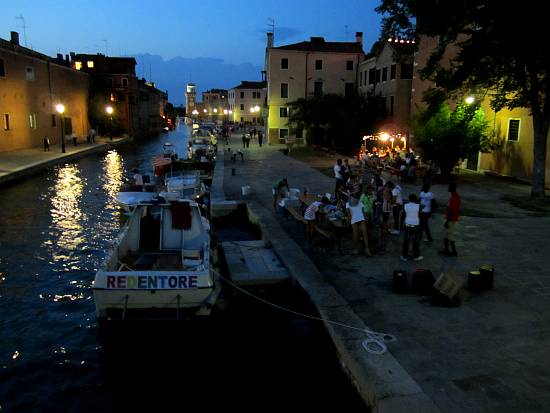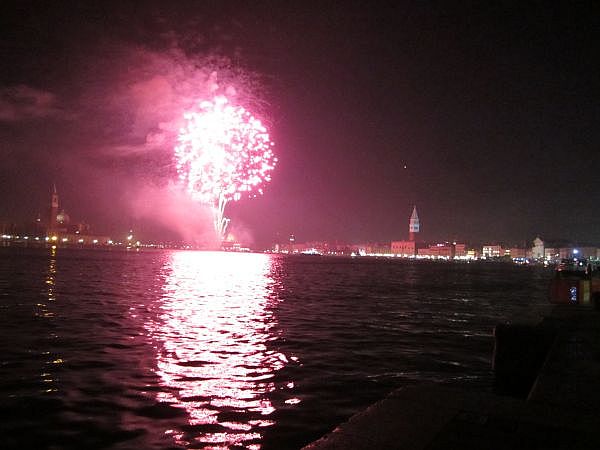All the best to everyone everywhere, especially anyone reading my blog. I hope 2013 is a sterling year for you. I mean, why not?
Santa Barbara floats by again

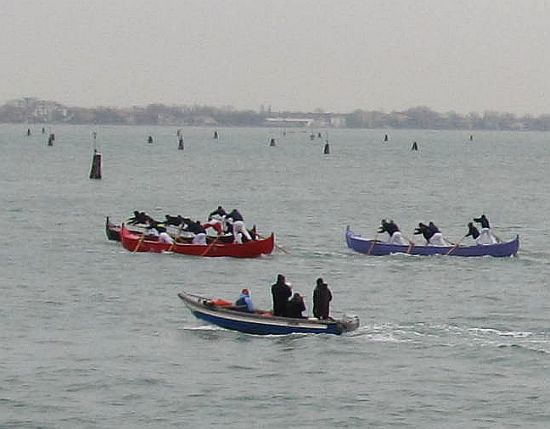
As you know, every December 4 (for the past 16 years now) the gondoliers who are ex-sailors organize a regata in honor of the patron saint of the Navy: Barbara.
This year, seeing that the supply of willing gondoliers and/or ex-sailors is shrinking, each caorlina carried the usual one (1) student from the Morosini Naval School, four (4) gondoliers and one (1) fireman. Barbara is also patron saint of firemen, as well as miners, artillerymen, and just about anybody who uses substances which explode.
Gondoliers also tend to explode when things don’t go right, as witnessed by the reaction of Franco Dei Rossi (nicknamed “Strigheta”) when his orange caorlina was cheated of its obviously well-deserved fourth place and consequent blue pennant. He used Ugly Words to the race judge, which was unfortunate; it was also too bad that many people could understand — nay, shared — his sentiments, as most naked eyes had seen his boat cross the finish line fourth.
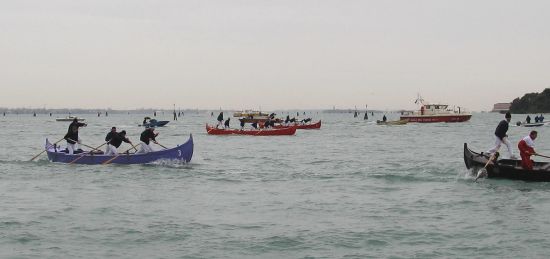
But righteous indignation and loud voices (though not Ugly Words) from somebody is almost always part of the tradition, along with rain (it was blazingly sunny the day before and the day after the regata — does Santa Barbara not like her regata?), cold, and a feast afterward featuring pasta and fagioli (beans) which, if it didn’t warm hearts which were still festering with rage, did a great job in warming our gizzards.
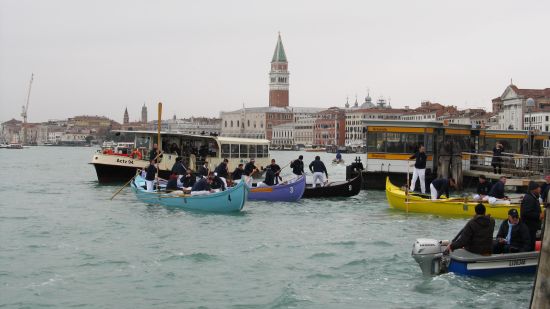
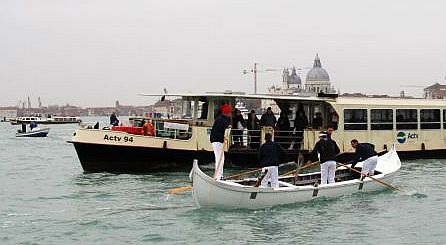
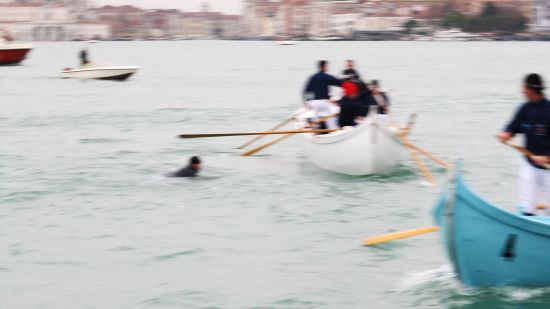
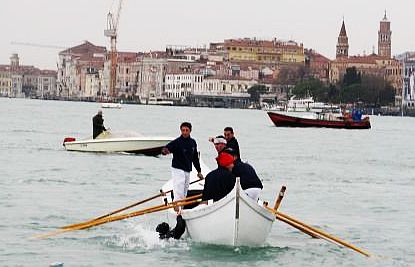


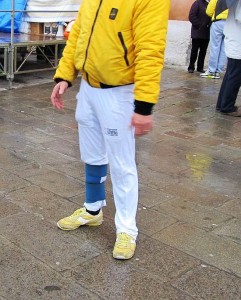
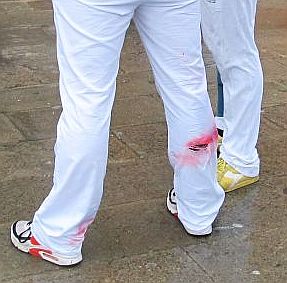
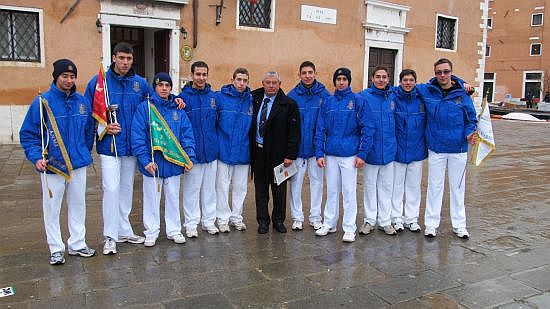
San Martino footnote
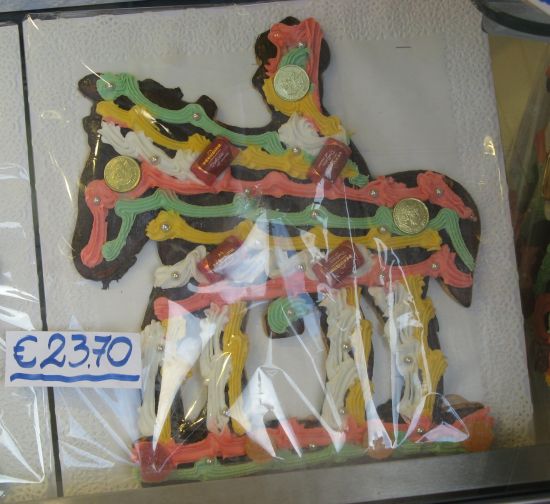
I don’t want Saint Martin’s day 2012 to be associated only with acqua alta and with the words which are being thrown about like fistfuls of gravel: “Disaster,” “Tempest,” “Catastrophe,” and so on.
There is no meteorological event which can get the upper hand of the cookie — the wonderful creation showing Saint Martin astride his horse, sometimes also with his sword upraised ready to cut his cloak in half, translated into dough, colored icing, sprinkles, and chunks of candy that cling to him and his trusty steed.
As I’ve mentioned elsewhere, these cookies come in all sizes, and all calibers of candy, and all are spectacularly overpriced. St. Martin would be ashamed of everybody if he could express himself.
But what’s interesting this year is the bit of history of these confections which I have learned from a leaflet attached to the overpriced cookie Lino gave me. There’s no stopping him: It’s tradition, and if we have to spend the egg-and-butter money for a crumbly San Martino, so be it.
I had assumed that this pastry was some newfangled confection invented by modern bakers looking for a new product for which to charge too much. But no.
Here is what the leaflet said (translated by me):
The custom of giving a San Martino made of shortcrust pastry was introduced and spread, most probably, by the pastrymakers who came from the Canton of Graubunden (Switzerland), who were present in massive numbers in Venice since the 15th century.
They had their own statutes in the scuola (guildhall) adjacent to the church of San Marcuola and near the ancient church of Santa Croce, in the homonymous sestiere, which was subsequently demolished in 1806. (Note: This would have been part of the massacre of Venetian churches, palaces, and guildhalls inflicted by Napoleon after the fall of the Venetian Republic in 1797.)
The archives reveal that more than 80 percent of the pastryshops were run by people from Graubunden, in whose favor the Venetian Senate issued special laws.
With the end of the Republic, due to the adverse political situation, the people of Graubunden were compelled, against their wishes, to leave the city, taking with them and diffusing in the major European cities the traditional Venetian pastry. (I’m all for local pride, but it’s interesting to note that according to this writer, the cookie came to Venice from Switzerland, but left Venice as Venetian. If I were Swiss, I’d object to that.)
The celebration of San Martino coincided with the end of the agricultural labor of the year. To celebrate this important moment, the Venetian patricians organized sumptuous banquets in their magnificent country villas, in which all their workers participated, and it was traditional to conclude the feast with a shortcrust pastry in the form of San Martino.
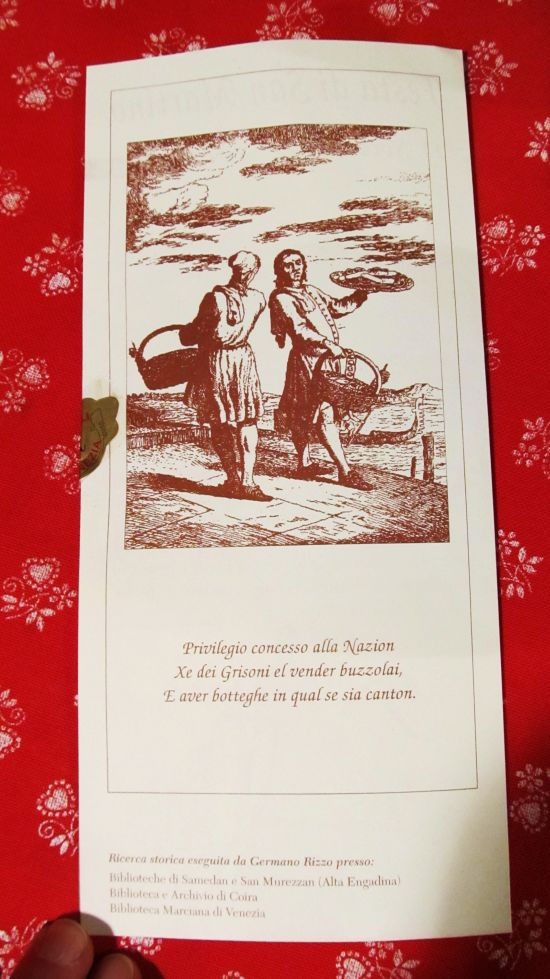
Redentore: the shore report
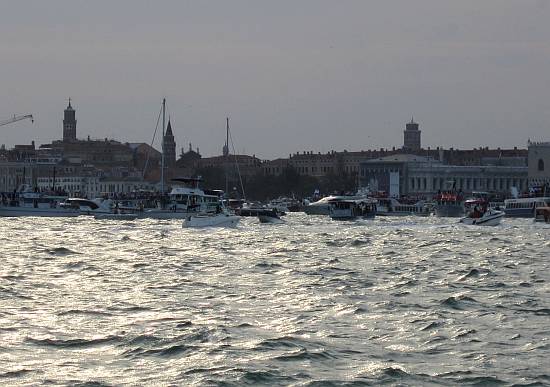
After all the mutterings on and about the eve of the big feast day (the eve, as you know, being at least as big as the day itself), here is how it all came out. I’ve waited a few days because I needed to let all the post-festa hot air, super-heated words, pumice dust, and floating cinders all burn out from the assorted arguments about what did and didn’t happen.
Here goes:
Good:
The wind dropped. The rain did not fall. There were something like 90,000 spectators/participants that evening, according to the Comune. (The firemen and the gondoliers at the Molo at Piazza San Marco estimated many fewer.) Whatever the number, I guess that’s good — anyway, people didn’t stay home in front of the TV eating soggy pizza.

Also good, though not a Good Sign: We didn’t go out in a boat, a decision we spent all evening congratulating ourselves on having made. We’d have been rammed to splinters, then sunk. And anyway, it wouldn’t have been any fun to be in a small wooden boat in the midst of the masses of floating migrating mammoths. We also discovered that being on shore meant you could see lots of other things going on, which was more diverting than settling for what you can see from a boat tied to a piling for hours on end.
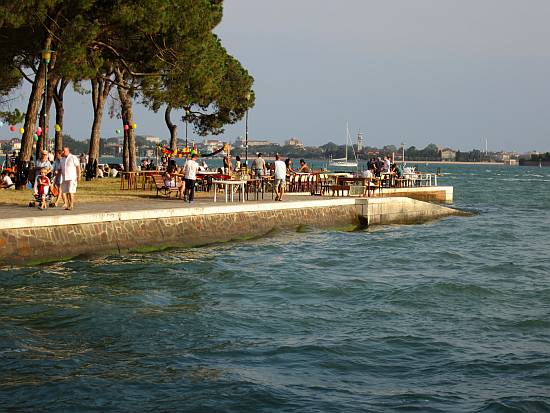
Not so good:
We didn’t go out in a boat. Like almost everybody else who has hung on to the Old Way, who even accepted the gracious concession a few years ago of a tiny patch of water dedicated to boats with oars where we could feel safe, we finally faced the fact that a motorless boat is a suicide boat. I don’t believe anyone went out in a craft powered by fewer than 40 horses.
There were very few topomotori and pescherecci, as far as I could see and rumor can report. The Gazzettino said that there were estimates of some 800 fewer boats than usual. In fact, they were almost completely absent. That’s a lot of no-shows.This has been interpreted as precisely the result desired by….. I don’t know who. “They.” “They don’t want Venetians anymore.” “They only want tourists who come and spend money.”
The waterfront which has customarily been left free for the pescherecci to tie up to was occupied by yachts.
In any case, the threats from the Capitaneria di Porto evidently had a powerful effect. Only 6-10 topomotori braved the hazardous waters of the Bacino supposed mined with fines.
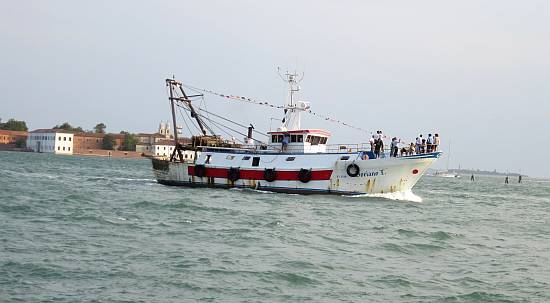
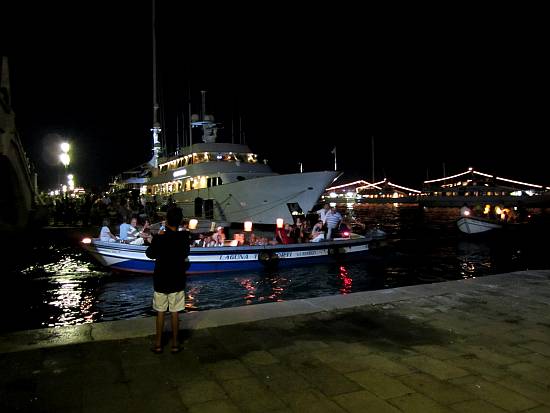
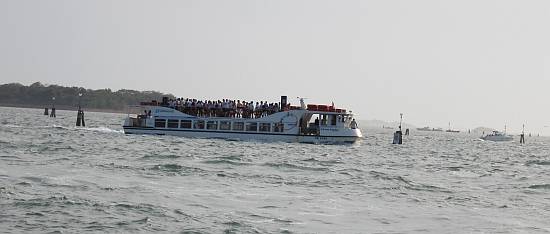
I add, for the record, that the newspaper states that the Comune had repeatedly denied that there were going to be massive document-checks — the mayor says it was a mysterious rumor accumulated via the internet that created all the tsuris. But the mayor also made clear that the Comune wasn’t in charge of the waters patrolled by the Capitaneria. This is akin to saying “I didn’t forbid you to get married, but I’m not a Justice of the Peace.” The mayor also denied that the threat of fines had any effect on the decision of people to come in topi or fishing boats. Next he’ll be telling us that gravity isn’t really what keeps everything stuck to the surface of the earth.
The sub-mayor for Tourism cheerfully said the absence of boats was probably due to the discouraging weather forecast, and that the absence of the working boats (full of Venetian families, I note) made the departure of smaller boats safer. My own experience of nearly 20 years out on the tumultuous waters of the Bacino after the last firework fades leads me to doubt this. The most hazardous boats aren’t the topomotori, but the big shiny craft loaded with people from the hinterland. It was noted that most of these craft were visibly overloaded, but nobody in uniform pulled up to demand to see their license and registration and lifejackets and safety flares and on and on and on.
Here is a summary of the no-working-boats-or-you’ll-be-fined situation. A mere 40 penalties were imposed, and that was for “viability violations,” which I take to mean parking in the middle of the road, so to speak.
The mayor said “The campaign spread (about the checking of working boats) turned out to be a boomerang. I myself denied many times any intention to turn the screws on the boats during the festa, but they preferred not to listen and now everybody can see who was right and who was wrong.”
“We took the warning seriously,” said Giovanni Grandesso, representing the working boats that belong to the artisans’ association. “The people were afraid. But what we were supposed to do? The vigili (local police) told us this in the presence of the sub-mayor for waterborne traffic. If this is said in an official meeting and the sub-mayor keeps quiet, what were we supposed to do? They also said, ‘You know perfectly well you’re not allowed to carry people.’ And this made us think. We then asked for a meeting with the office of the sub-mayor, but it was all too late. All that was needed was to have clarified this at the beginning — it’s too easy to tell us now that we misunderstood.”
As you see, all the fireworks don’t explode in the sky.
And speaking of fireworks:
The fireworks: Quantity: The show was curtailed from 45 minutes to 32. (Lest we might be tempted to forget that “no ghe xe schei.”)
The fireworks: Quality: What we saw was evidently culled from the “factory seconds,” “slightly defective,” “previously owned” barrel because they were possibly the most boring pyrotechnics I’ve ever seen. I am a fireworks fanatic, so it actually takes very little to please me. But these were so generic, so predictable, so perfunctory that even ten minutes of stale rocketry seemed like 45. Lino and I (we discovered later) were both standing there thinking, “Can we go home now?” Of course we could have gone home, but we each thought the other wanted to stay, so we said nothing in order to be good sports. That shows how much difference it made for me to learn to speak Italian: None. You might know 15,000 words and be able to conjugate every verb down to the remote past imperfect, but in order to communicate you’ve got to actually say something.
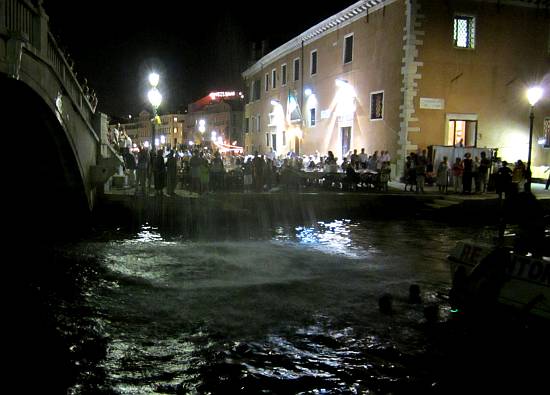
Terrifyingly Not Good: While everybody was getting themselves worked into a lather about what could happen to somebody out there in a boat, nobody gave any thought to what could happen to somebody on a packed-solid vaporetto dock at 1:30 in the morning.
Because the dock was mobbed — and mobs tend to think in big simple terms like “Me! First! Now!” and not in terms like “Watch your step” or “After you, my dear Alphonse” — somebody almost got crushed between the arriving vaporetto and the dock.
As the vaporetto (also overloaded with people thinking in big simple terms) began to pull up to the dock to tie up and let people on and off, the heavy waves caused by the departing mammoths in the darkness made the equally heavy and bulky vehicle leap and plunge. The mob on the dock began to push forward get nearer the edge to be ready to get on (“Me! First!”). The girl slipped and fell between the dock and the boat.
She managed to grab onto the edge, thanks to her backpack snagging on something on the way down, so she didn’t fall completely in the water. It’s not clear how the vaporetto managed to avoid performing one of its famous plunges against her, the kind that even on a normal day make the dock shake and the metal of the boat’s hull reverberate.
Somehow she got dragged up and out before she was reduced to kindling. The ambulance took her to the hospital, where the doctors stated that she’d been “miracled,” as the Italian verb so neatly puts it. If the waves had been bigger she’d have had at least a shattered pelvis.
Solution: Station pontonieri on every dock all night. These are the individuals at work on certain busy docks who keep the chain stretched that prevents the public from moving toward the boat till it’s stopped and the passengers have gotten off. The fact that evidently human instinct doesn’t lead you naturally toward this behavior means that a person has to be paid to stand directly in your way with a chain. But it works.
My conclusion, based on nothing remotely resembling scientific calculations, is that the truly Venetian festa has already begun to move ashore. It’s a hell of a note, but it was more fun to be with the families and dogs on the street than out on the water surrounded by drunken disco dancing outlanders. The mayor would probably disagree.
